A Low-Frequency MEMS Piezoelectric Energy Harvesting System Based on Frequency Up-Conversion Mechanism
Abstract
1. Introduction
2. Design and Simulation
2.1. Device Configuration
2.2. Modal Analysis Using COMSOL
3. Micro Fabrication Process
4. Experimental Results and Discussion
4.1. The Output Performance of the SPC
4.2. The Output Performance of the PEHS
5. Conclusions
Author Contributions
Funding
Conflicts of Interest
References
- Jung, I.; Shin, Y.-H.; Kim, S.; Choi, J.; Kang, C.-Y. Flexible piezoelectric polymer-based energy harvesting system for roadway applications. Appl. Energy 2017, 197, 222–229. [Google Scholar] [CrossRef]
- Hou, C.; Chen, T.; Li, Y.; Huang, M.; Shi, Q.; Liu, H.; Sun, L.; Lee, C. A rotational pendulum based electromagnetic/triboelectric hybrid-generator for ultra-low-frequency vibrations aiming at human motion and blue energy applications. Nano Energy 2019, 63, 103871. [Google Scholar] [CrossRef]
- Wu, J.; Yuan, S.; Zhao, X.; Yin, Y.; Ye, W. A wireless sensor network node designed for exploring a structural health monitoring application. Smart Mater. Struct. 2007, 16, 1898–1906. [Google Scholar] [CrossRef]
- Ahmad, I.; Khan, F.U. Multi-mode vibration based electromagnetic type micro power generator for structural health monitoring of bridges. Sens. Actuators, A. 2018, 275, 154–161. [Google Scholar] [CrossRef]
- Shaikh, F.K.; Zeadally, S. Energy harvesting in wireless sensor networks: A comprehensive review. Renewable Sustainable Energy Rev. 2016, 55, 1041–1054. [Google Scholar] [CrossRef]
- Zhao, X.; Cai, J.; Guo, Y.; Li, C.; Wang, J.; Zheng, H. Modeling and experimental investigation of an AA-sized electromagnetic generator for harvesting energy from human motion. Smart Mater. Struct. 2018, 27, 085008. [Google Scholar] [CrossRef]
- Liu, H.; Hou, C.; Lin, J.; Li, Y.; Shi, Q.; Chen, T.; Sun, L.; Lee, C. A non-resonant rotational electromagnetic energy harvester for low-frequency and irregular human motion. Appl. Phys. Lett. 2018, 113, 203901. [Google Scholar] [CrossRef]
- Liu, H.; Lee, C.; Kobayashi, T.; Tay, C.J.; Quan, C. Piezoelectric MEMS-based wideband energy harvesting systems using a frequency-up-conversion cantilever stopper. Sens. Actuators, A 2012, 186, 242–248. [Google Scholar] [CrossRef]
- Fan, K.; Tan, Q.; Zhang, Y.; Liu, S.; Cai, M.; Zhu, Y. A monostable piezoelectric energy harvester for broadband low-level excitations. Appl. Phys. Lett. 2018, 112, 123901. [Google Scholar] [CrossRef]
- Wang, J.; Wen, S.; Zhao, X.; Zhang, M.; Ran, J. Piezoelectric Wind Energy Harvesting from Self-Excited Vibration of Square Cylinder. J. Sensors 2016, 2016, 2353517. [Google Scholar] [CrossRef]
- Zi, Y.; Lin, L.; Wang, J.; Wang, S.; Chen, J.; Fan, X.; Yang, P.K.; Yi, F.; Wang, Z.L. Triboelectric-pyroelectric-piezoelectric hybrid cell for high-efficiency energy-harvesting and self-powered sensing. Adv. Mater. 2015, 27, 2340–2347. [Google Scholar] [CrossRef]
- Yoo, D.; Park, S.-C.; Lee, S.; Sim, J.-Y.; Song, I.; Choi, D.; Lim, H.; Kim, D.S. Biomimetic anti-reflective triboelectric nanogenerator for concurrent harvesting of solar and raindrop energies. Nano Energy 2019, 57, 424–431. [Google Scholar] [CrossRef]
- Zhang, Y.; Wang, T.; Luo, A.; Hu, Y.; Li, X.; Wang, F. Micro electrostatic energy harvester with both broad bandwidth and high normalized power density. Appl. Energy 2018, 212, 362–371. [Google Scholar] [CrossRef]
- Naito, Y.; Uenishi, K. Electrostatic MEMS Vibration Energy Harvesters inside of Tire Treads. Sensors 2019, 19, 890. [Google Scholar] [CrossRef]
- Han, D.; Yun, K.-S. Piezoelectric energy harvester using mechanical frequency up conversion for operation at low-level accelerations and low-frequency vibration. Microsyst. Technol. 2014, 21, 1669–1676. [Google Scholar] [CrossRef]
- Tang, G.; Yang, B.; Liu, J.; Xu, B.; Zhu, H.; Yang, C. Development of high performance piezoelectric d33 mode MEMS vibration energy harvester based on PMN-PT single crystal thick film. Sens. Actuators, A 2014, 205, 150–155. [Google Scholar] [CrossRef]
- Zawada, T.; Hansen, K.; Lou-Moeller, R.; Ringgaard, E.; Pedersen, T.; Thomsen, E.V. High-performance piezoelectric thick film based energy harvesting micro-generators for MEMS. Procedia Eng. 2010, 5, 1164–1167. [Google Scholar] [CrossRef][Green Version]
- He, X.; Wen, Q.; Lu, Z.; Shang, Z.; Wen, Z. A micro-electromechanical systems based vibration energy harvester with aluminum nitride piezoelectric thin film deposited by pulsed direct-current magnetron sputtering. Appl. Energy 2018, 228, 881–890. [Google Scholar] [CrossRef]
- Elfrink, R.; Kamel, T.M.; Goedbloed, M.; Matova, S.; Hohlfeld, D.; van Andel, Y.; van Schaijk, R. Vibration energy harvesting with aluminum nitride-based piezoelectric devices. J. Micromech. Microeng. 2009, 19, 094005. [Google Scholar] [CrossRef]
- Joshi, S.; Nayak, M.M.; Rajanna, K. Effect of post-deposition annealing on transverse piezoelectric coefficient and vibration sensing performance of ZnO thin films. Appl. Surf. Sci. 2014, 296, 169–176. [Google Scholar] [CrossRef]
- Md Ralib, A.A.; Nordin, A.N.; Salleh, H.; Othman, R. Fabrication of aluminium doped zinc oxide piezoelectric thin film on a silicon substrate for piezoelectric MEMS energy harvesters. Microsyst. Technol. 2012, 18, 1761–1769. [Google Scholar] [CrossRef]
- Tanaka, K.; Konishi, T.; Ide, M.; Sugiyama, S. Wafer bonding of lead zirconate titanate to Si using an intermediate gold layer for microdevice application. J. Micromech. Microeng. 2006, 16, 815–820. [Google Scholar] [CrossRef]
- Yang, B.; Zhu, Y.B.; Wang, X.Z.; Liu, J.Q.; Chen, X.; Yang, C.S. High performance PZT thick films based on bonding technique for d31 mode harvester with integrated proof mass. Sens. Actuators, A 2014, 214, 88–94. [Google Scholar] [CrossRef]
- Tang, G.; Liu, J.; Yang, B.; Luo, J.; Liu, H.; Li, Y.; Yang, C.; He, D.; Dao, V.D.; Tanaka, K.; et al. Fabrication and analysis of high-performance piezoelectric MEMS generators. J. Micromech. Microeng. 2012, 22, 065017. [Google Scholar] [CrossRef]
- Lei, A.; Xu, R.; Thyssen, A.; Stoot, A.C.; Christiansen, T.L.; Hansen, K.; Lou-Moller, R.; Thomsen, E.V.; Birkelund, K. MEMS-based thick film PZT vibrational energy harvester. In Proceedings of the 2011 IEEE 24th International Conference on Micro Electro Mechanical Systems, Cancun, Mexico, 23–27 January 2011; pp. 125–128. [Google Scholar]
- Cui, Y.; Zhang, Q.; Yao, M.; Dong, W.; Gao, S. Vibration piezoelectric energy harvester with multi-beam. AIP Adv. 2015, 5, 041332. [Google Scholar] [CrossRef]
- Licheng, D.; Zhiyu, W.; Xingqiang, Z.; Chengwei, Y.; Guoxi, L.; Jike, M. High Voltage Output MEMS Vibration Energy Harvester in d31 Mode With PZT Thin Film. J. Microelectromech. Syst. 2014, 23, 855–861. [Google Scholar] [CrossRef]
- Xu, R.; Lei, A.; Dahl-Petersen, C.; Hansen, K.; Guizzetti, M.; Birkelund, K.; Thomsen, E.V.; Hansen, O. Screen printed PZT/PZT thick film bimorph MEMS cantilever device for vibration energy harvesting. Sens. Actuators, A 2012, 188, 383–388. [Google Scholar] [CrossRef]
- Wang, Z.; Miao, J.; Tan, C.W. Acoustic transducers with a perforated damping backplate based on PZT/silicon wafer bonding technique. Sens. Actuators, A 2009, 149, 277–283. [Google Scholar] [CrossRef]
- Janphuang, P.; Lockhart, R.; Uffer, N.; Briand, D.; de Rooij, N.F. Vibrational piezoelectric energy harvesters based on thinned bulk PZT sheets fabricated at the wafer level. Sens. Actuators, A 2014, 210, 1–9. [Google Scholar] [CrossRef]
- Lin, S.-C.; Wu, W.-J. Fabrication of PZT MEMS energy harvester based on silicon and stainless-steel substrates utilizing an aerosol deposition method. J. Micromech. Microeng. 2013, 23, 125028. [Google Scholar] [CrossRef]
- Li, G.; Yi, Z.; Hu, Y.; Liu, J.; Yang, B. High-performance low-frequency MEMS energy harvester via partially covering PZT thick film. J. Micromech. Microeng. 2018, 28, 095007. [Google Scholar] [CrossRef]
- Ju, S.; Ji, C.-H. Impact-based piezoelectric vibration energy harvester. Appl. Energy 2018, 214, 139–151. [Google Scholar] [CrossRef]
- Pillatsch, P.; Yeatman, E.M.; Holmes, A.S. A piezoelectric frequency up-converting energy harvester with rotating proof mass for human body applications. Sens. Actuators, A 2014, 206, 178–185. [Google Scholar] [CrossRef]
- Galchev, T.V. Energy Scavenging From Low Frequency Vibrations. IEEE Sens. J. 2008, 8, 261–268. [Google Scholar]
- Galchev, T.; Aktakka, E.E.; Najafi, K. A Piezoelectric Parametric Frequency Increased Generator for Harvesting Low-Frequency Vibrations. J. Microelectromech. Syst. 2012, 21, 1311–1320. [Google Scholar] [CrossRef]
- Umeda, M.; Nakamura, K.; Ueha, S. Energy Storage Characteristics of a Piezo-Generator using Impact Induced Vibration. Jpn. J. Appl. Phys. 1997, 36, 3146–3151. [Google Scholar] [CrossRef]
- Halim, M.A.; Park, J.Y. Theoretical modeling and analysis of mechanical impact driven and frequency up-converted piezoelectric energy harvester for low-frequency and wide-bandwidth operation. Sens. Actuators, A 2014, 208, 56–65. [Google Scholar] [CrossRef]
- Jung, S.-M.; Yun, K.-S. Energy-harvesting device with mechanical frequency-up conversion mechanism for increased power efficiency and wideband operation. Appl. Phys. Lett. 2010, 96, 111906. [Google Scholar] [CrossRef]
- Andò, B.; Baglio, S.; Marletta, V.; Bulsara, A.R. Modeling a Nonlinear Harvester for Low Energy Vibrations. IEEE Trans. Instrum. Meas. 2019, 68, 1619–1627. [Google Scholar] [CrossRef]
- Yao, L.Q.; Zhang, J.G.; Lu, L.; Lai, M.O. Nonlinear Dynamic Characteristics of Piezoelectric Bending Actuators Under Strong Applied Electric Field. J. Microelectromech. Syst. 2004, 13, 645–652. [Google Scholar] [CrossRef]
- Gu, L.; Livermore, C. Impact-driven, frequency up-converting coupled vibration energy harvesting device for low frequency operation. Smart Mater. Struct. 2011, 20, 045004. [Google Scholar] [CrossRef]
- Chen, S.; Ma, L.; Chen, T.; Liu, H.C.; Sun, L.N.; Wang, J.X. Modeling and verification of a piezoelectric frequency-up-conversion energy harvesting system. Microsyst. Technol. 2017, 23, 2459–2466. [Google Scholar] [CrossRef]
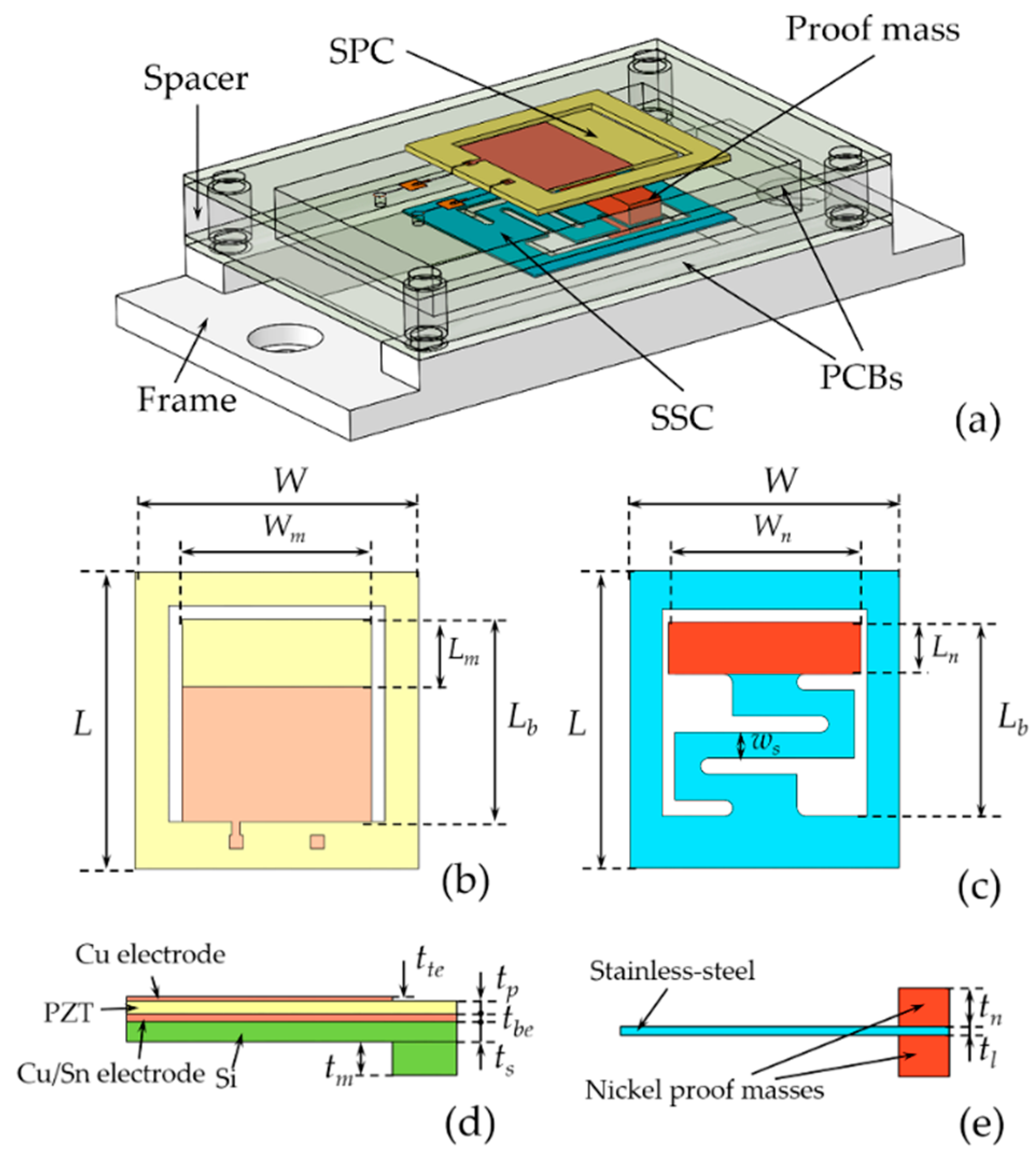


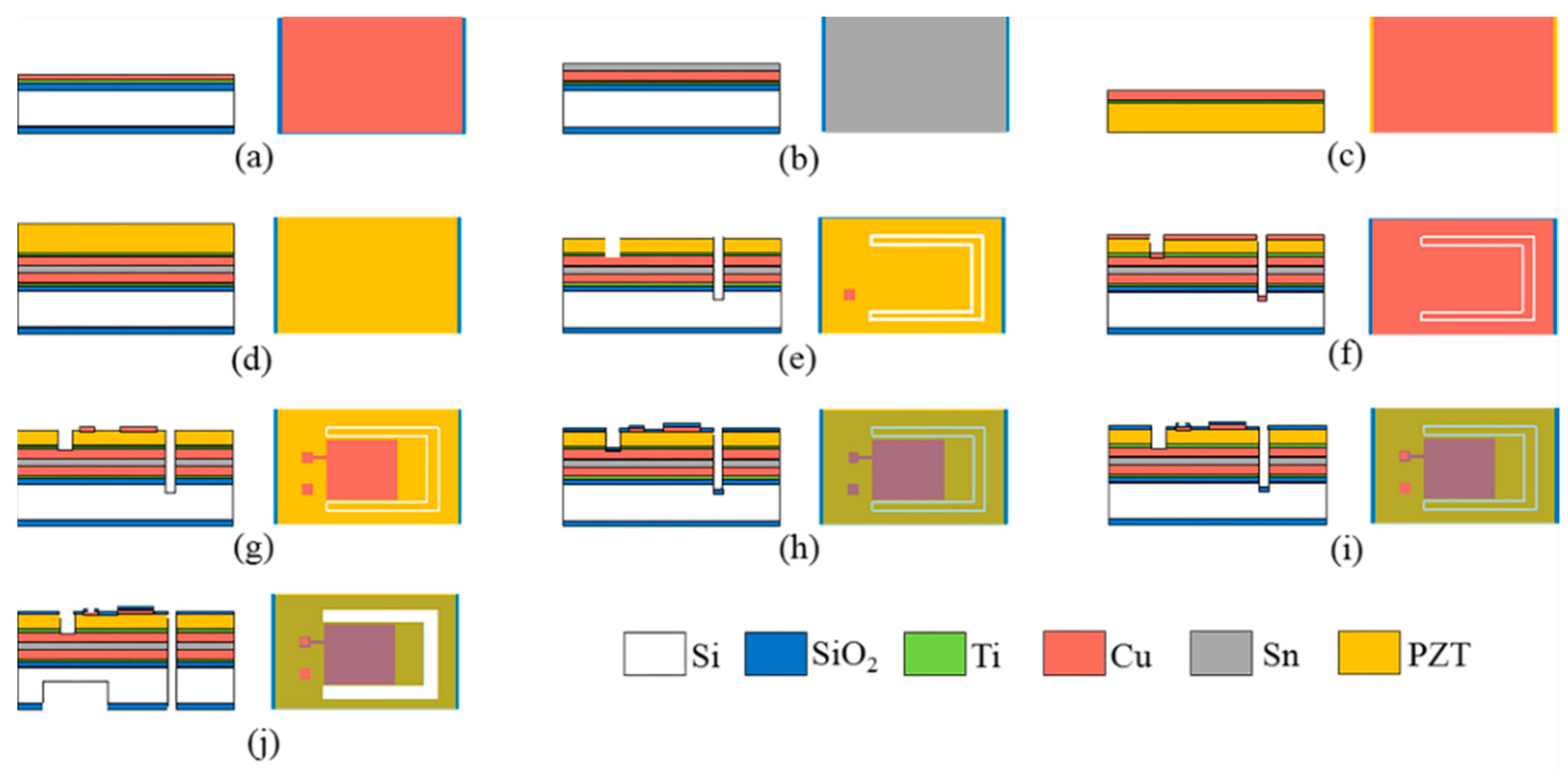

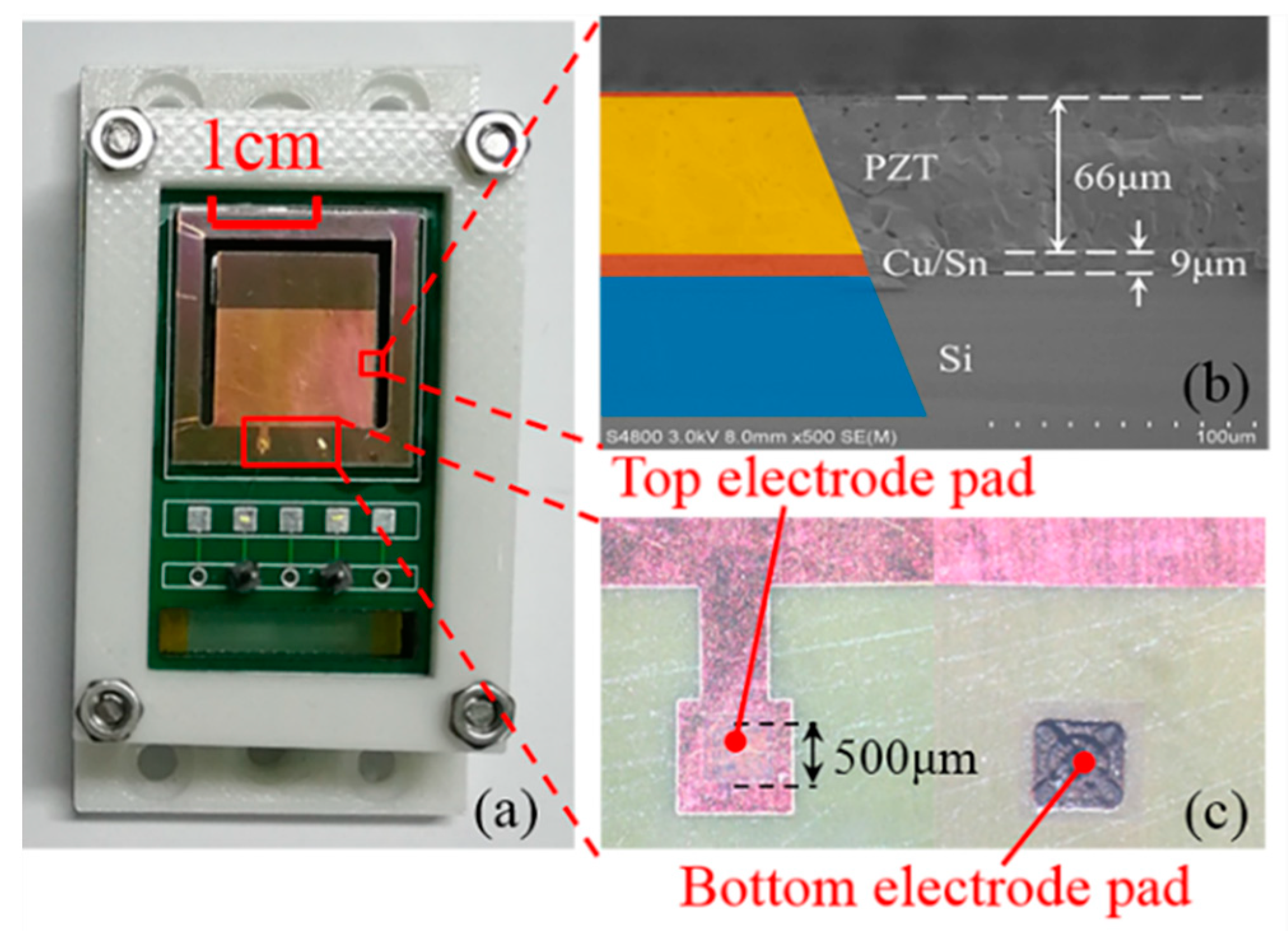
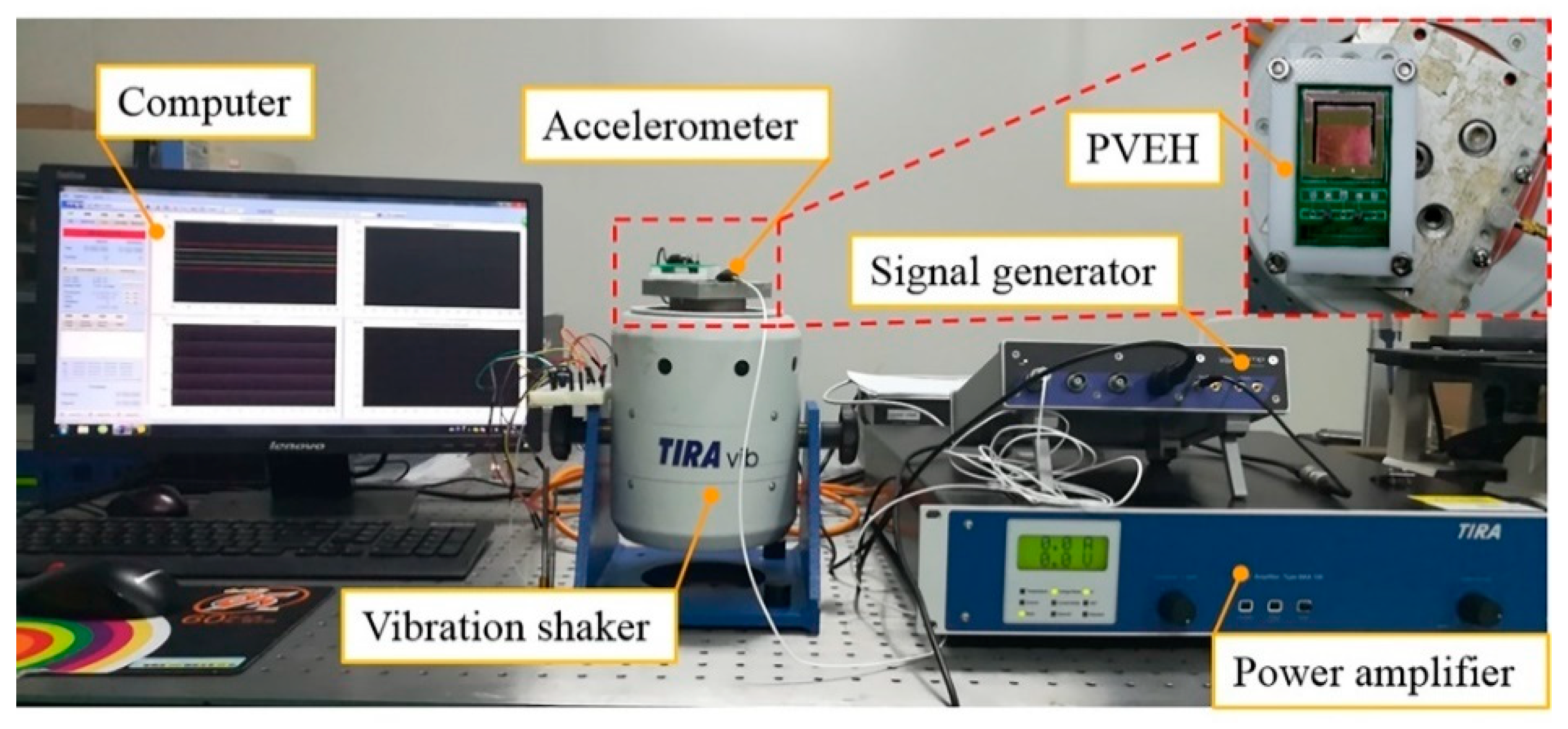
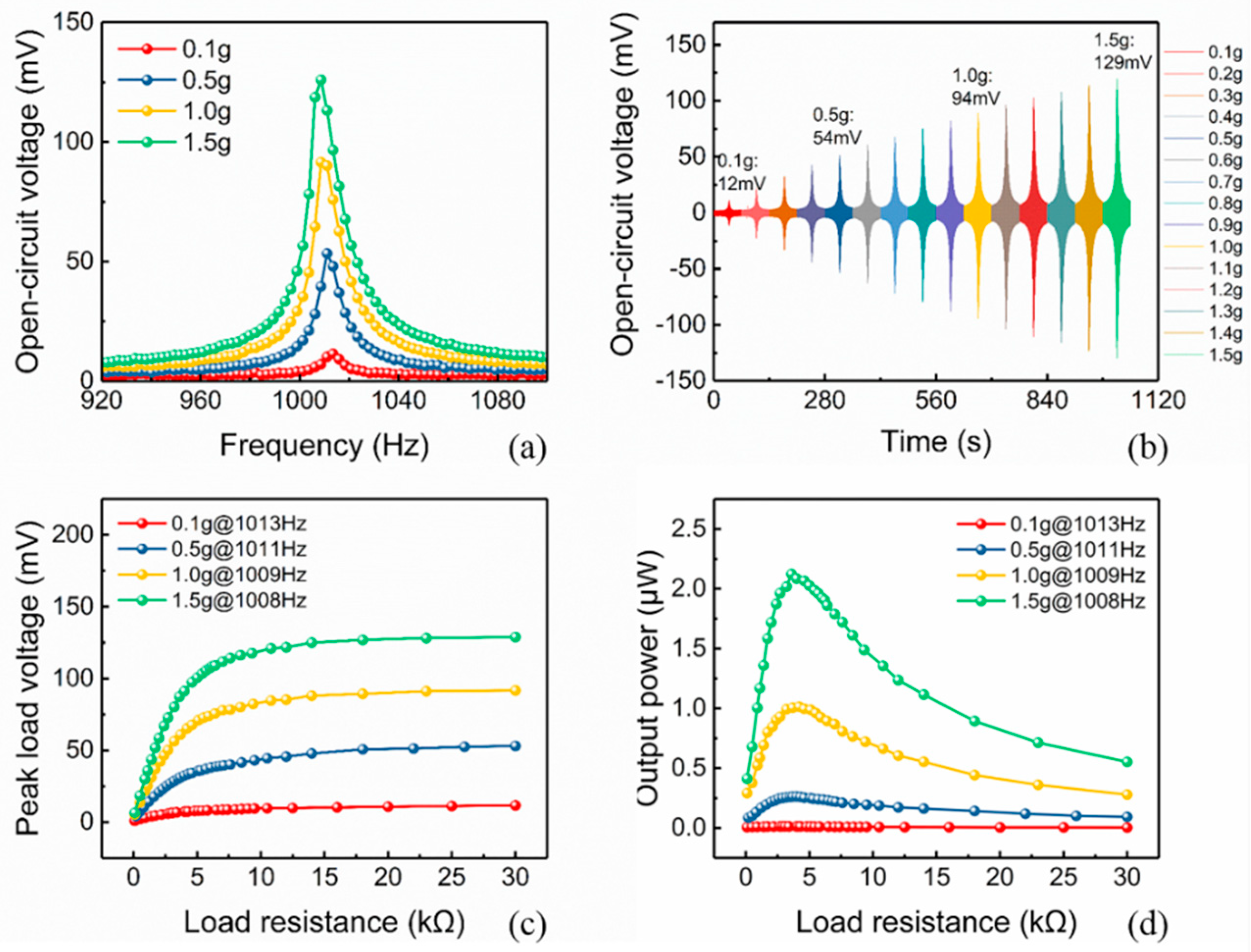

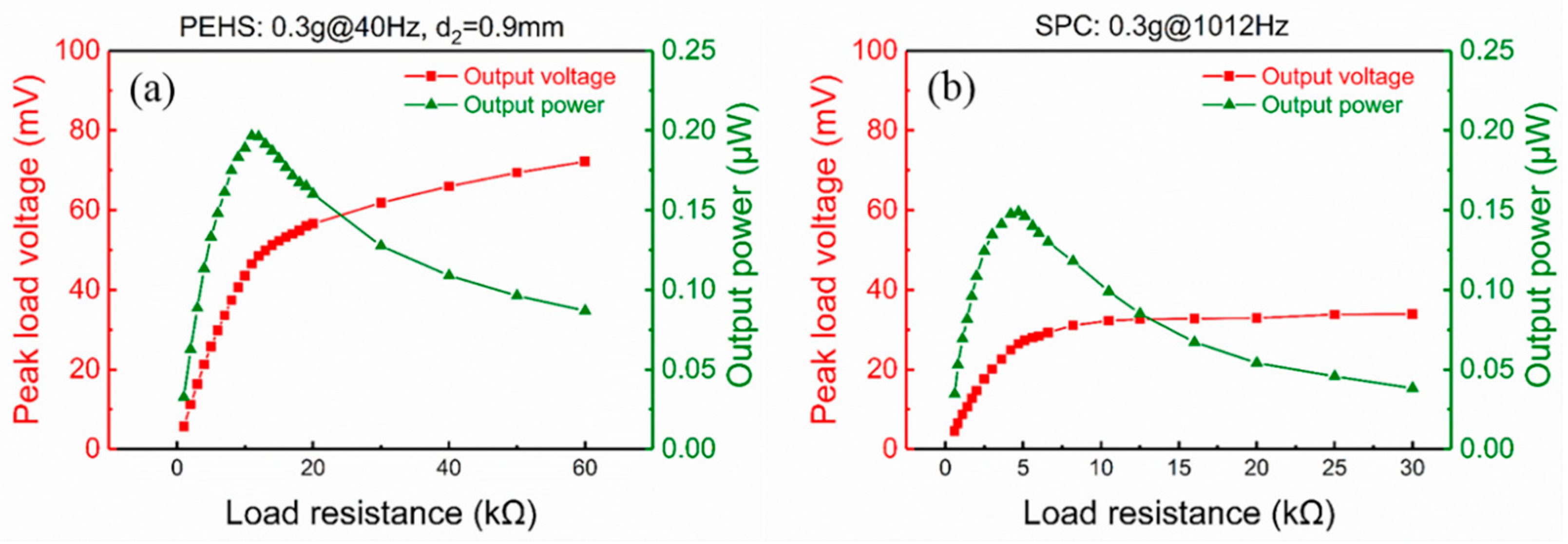
| Parameters | Description | Value |
|---|---|---|
| L | Total length of the chip | 22 mm |
| W | Total width of the chip | 21 mm |
| Lb | Length of the cantilever beam | 15 mm |
| Lm | Length of the Si proof mass | 5 mm |
| Wm | Width of the Si proof mass | 14 mm |
| Ln | Length of the nickel proof mass | 15 mm |
| Wn | Width of the nickel proof mass | 5 mm |
| ws | Width of the S-shaped cantilever | 1.5 mm |
| tte | Thickness of the top Cu electrode | 1 μm |
| tp | Thickness of the PZT layer | 65 μm |
| tbe | Thickness of the bottom electrode | 9 μm |
| ts | Thickness of the Si substrate | 200 μm |
| tm | Thickness of the Si proof mass | 300 μm |
| tn | Thickness of the nickel proof mass | 3 mm |
| tl | Thickness of the stainless-steel cantilever | 100 μm |
© 2019 by the authors. Licensee MDPI, Basel, Switzerland. This article is an open access article distributed under the terms and conditions of the Creative Commons Attribution (CC BY) license (http://creativecommons.org/licenses/by/4.0/).
Share and Cite
Huang, M.; Hou, C.; Li, Y.; Liu, H.; Wang, F.; Chen, T.; Yang, Z.; Tang, G.; Sun, L. A Low-Frequency MEMS Piezoelectric Energy Harvesting System Based on Frequency Up-Conversion Mechanism. Micromachines 2019, 10, 639. https://doi.org/10.3390/mi10100639
Huang M, Hou C, Li Y, Liu H, Wang F, Chen T, Yang Z, Tang G, Sun L. A Low-Frequency MEMS Piezoelectric Energy Harvesting System Based on Frequency Up-Conversion Mechanism. Micromachines. 2019; 10(10):639. https://doi.org/10.3390/mi10100639
Chicago/Turabian StyleHuang, Manjuan, Cheng Hou, Yunfei Li, Huicong Liu, Fengxia Wang, Tao Chen, Zhan Yang, Gang Tang, and Lining Sun. 2019. "A Low-Frequency MEMS Piezoelectric Energy Harvesting System Based on Frequency Up-Conversion Mechanism" Micromachines 10, no. 10: 639. https://doi.org/10.3390/mi10100639
APA StyleHuang, M., Hou, C., Li, Y., Liu, H., Wang, F., Chen, T., Yang, Z., Tang, G., & Sun, L. (2019). A Low-Frequency MEMS Piezoelectric Energy Harvesting System Based on Frequency Up-Conversion Mechanism. Micromachines, 10(10), 639. https://doi.org/10.3390/mi10100639







